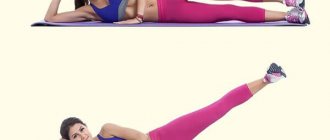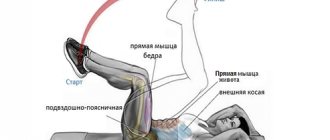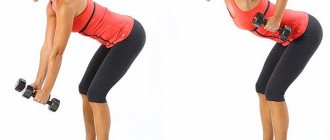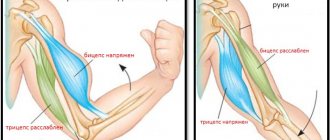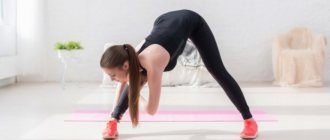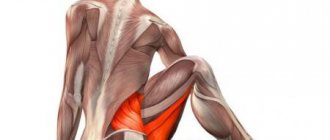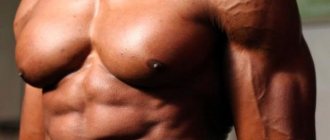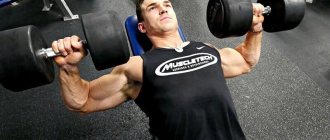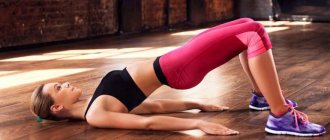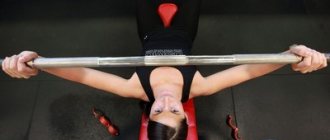The next muscle in my review is the Serratus Anterior Muscle (SAM). It also refers to the muscles that move the PP forward. If you follow a series of posts about, then you know what PP is, I won’t dwell on it.
Start – Attachment.
The PZM is located on the outer lateral surface of the chest and is covered by the pectoral muscles. It starts from the upper 8-9 ribs and attaches to the inner (closer to the spine) edge and lower corner of the scapula.
Function.
The PZM moves the scapula forward. Actively participates in boxing movements ( straight punch
), fencing lunge. The lower teeth of the PZM lower the blade and pull its lower angle down and forward.
Characteristics.
In terms of its target movements, BG is an agonist
, by auxiliary actions to other muscle groups
as a synergist
, by opposing the traction muscles
by an antagonist
.
Exercises for the Serratus Anterior Muscle.
In principle, all movements where the RA extends forward relative to the spinal column are suitable. So that the blade moves forward:
- Different types of push-ups. The descent to the lowest point should be as deep as possible.
Dips. If possible, descend deeper to the lowest point ( if the shoulder joints allow
).
Movements with a load in the hands, simulating direct blows ( with the shoulder turned forward
).
Also, the PZM is involved in the movements of hanging on the bar ( the lower teeth resist gravity
):
- Pull-ups to the bar (initial phase
).
Raising your legs to the bar.
With external weight.
- Traction on a vertical block ( synergist, lower fibers
).
These are the main movements in which PZM participates. As you noticed, the muscle works more “readily” with exercises that use your own body weight. This is due to the fact that the amplitude of useful work in the PZM is small, the muscle is located close to the spinal column. But, in general, the PZM is involved in all complex movements of a pressing and pulling nature that the PP performs. For example, push-ups with a barbell or barbell or dumbbell/kettlebell presses up.
How to pump up the serratus anterior muscles Training various muscle groups is the basis of any training system. To build a beautiful torso, it is not enough to do only exercises to train the pectoral, latissimus and abdominal muscles. These groups and their aesthetic beauty can be emphasized by training the serratus muscles. They are a small but very important detail in the overall picture of a trained body. In order to give an indirect load to the serratus muscles, it is necessary to perform exercises to train the back, chest and shoulders. Stretching and compressing the chest, as well as adducting and abducting the arms from the body are the main types of exercises. Purpose of the serratus muscles The serratus anterior muscle allows you to move the shoulder blades forward and outward. In conjunction with the muscles of other groups, it raises its arms above the horizon line and participates in the expansion of the chest. It is based on the functions that the serratus muscles perform that we can draw a conclusion about the most suitable exercises for training them. During training, you should repeat exactly those movements that are physiologically characteristic of these muscles. But despite this, identifying specific exercises is not easy. The serratus muscles are worked indirectly, during training of other muscle groups. This is because it is impossible to isolate them during training. The serratus muscles experience the greatest tension when working on the pectoral and deltoid muscles. To create the most suitable training system, you need to determine a set of exercises that will pump both the serratus and other muscle groups. Exercises for the serratus muscles Latissimus Muscles pose To properly train the serratus anterior muscle, special attention should be paid to performing static exercises. A set of such training can be carried out both with and without load. It is best to train the serratus anterior muscle with a static “latissimus” exercise. To perform this exercise correctly, like any other, you need to study its technique in detail. It is necessary to take the correct starting position - hands rest on the sides of the body, feet shoulder-width apart, stand straight. When performing the exercise, movements will be carried out in the upper part of the body. The movement should begin by creating tension in the latissimus dorsi muscles. At the same time, we bend our lower back and push our chest forward. Thus, the shoulder girdle moves back and then, together with the elbows, moves forward. The shoulder blades should be kept as far apart as possible and shifted forward. Once you feel the point of maximum tension, you should stay in this position for as long as possible. It is at this moment that the serratus anterior muscle is in a state of greatest static tension. After completing the exercise, you should relax all tense muscle groups and stretch a little. This exercise must be performed in several approaches, but at least three. Exercise with load Another interesting exercise for pumping up the serratus muscles is performing exercises with weights. The greatest effect can be achieved by using a dumbbell in training and performing a pullover exercise. To get into the starting position, you need to lie down on a bench, holding a dumbbell in your hands. Particular attention should be paid to the method of holding the dumbbell in your hands: holding one end of the dumbbell with both hands. While holding the dumbbell, you need to extend your arms vertically upward and bend them slightly at the elbows. Pullover with a dumbbell After taking the starting position, we proceed to the actual execution of the exercise. Without bending your arms, you should smoothly lower the dumbbell down. While performing this movement, take an active breath. At this moment you will feel a stretch in your chest. In this position, you need to linger a little and, while exhaling, smoothly return to the starting position. Perform the required number of repetitions of the exercise. It is very important to check the fastening of the plates before performing this exercise. Unreliably fixed parts of the dumbbell can seriously injure you. You also need to follow the breathing technique: inhale when lowering your arms with a dumbbell, exhale when returning your arms to their original position. To achieve maximum effect, the training process should be carried out in 3-5 approaches, with 15-20 repetitions. These exercises train not only the serratus muscles, but also the abdominal muscles, chest muscles, latissimus dorsi muscles, and trapezius muscles. Dumbbell pullovers can also be performed while sitting across a bench. Only the upper part of the back is placed on it, and the legs rest on the floor. Having taken the starting position, you need to ensure that your pelvis is below the level of the bench and your head is in weight. After this, pick up a dumbbell placed on the edge of the bench and begin to perform the exercise. Another exercise that is good for developing serratus muscles is diagonal crunches. You can read about how to do them in our article on how to burn belly fat. By including the exercises described above in your training complex, you can significantly work the serratus anterior muscles, which will give your torso additional impressiveness and definition.
Our back is a complex muscle group. In terms of quantity, it is second only to the legs. Almost all athletes know the names of the main muscles - rhomboids, latissimus, trapezius, deltoid and lumbar. They work purposefully and persistently to create strong back muscles. To obtain an expressive relief, it is not enough to highlight only the main muscles of the torso. To get an athlete's figure, you need to include and work out the serratus muscles. They are classified as small muscle groups and are located on the sides of the chest. Of course, during training the serratus muscles are indirectly involved, but they are not worked enough to achieve an effect.
Basic rules and nuances
How to pump up the serratus muscle in the gym? What exercises are suitable for pumping up the serratus muscles at home? Once you start working on these additional muscles, you shouldn’t expect results right away. The athlete's relief, which attracts admiring and envious glances, is the result of diligent hard work. Their drawing requires a long period. There are a number of exercises to isolate this muscle group.
When starting training to pump up the serratus muscles, do not focus on weight. Pay attention to the number of approaches. The exercises must be performed with a static load. In this case, statics will help you feel and work out the intercostal muscles of the pectoral muscle group. Do training to pump up the serratus muscles at the end of the session. It was then that you already warmed up the body and saturated it with oxygen. In this case, the risk of stretching or injuring muscles (tendons) is reduced to a minimum. These basic rules must be followed both in the gym and at home.
With a barbell
A pullover with a barbell is not much different from the version with a dumbbell. The bar is taken with a straight grip. The grip width may vary, but it is recommended to place your hands approximately shoulder-width apart, but not wider, so as not to reduce the effectiveness of the exercise.
https://youtu.be/vCOG1gVBZ2M
In the case of a barbell, the most common option is to perform a pullover lying along the bench, and not across it. Make sure that your feet rest firmly on the floor and do not lift your pelvis (while moving the projectile behind your head).
Lower the bar smoothly, without jerking. The arms are lowered to approximately parallel with the floor or slightly lower.
Basic set of exercises
How to pump up the serratus muscle on the horizontal bar? Hang on the bar, the distance between your hands is 20-30 centimeters wider than your shoulders. Completely relax your back and shoulder muscles. With your leg bent at the knee, slowly and calmly lift it until you touch the opposite side of your chest. The time to hold the knee at the top point is from 4 to 6 seconds. After a while, complicate the task - try to reach the opposite shoulder. Change legs. The optimal number of visits is from 12 to 15 times. This way you will pump up the serratus abdominal muscles and also work the broad dorsal muscles.
The starting position of the next exercise is lying on a sports board or bench. Execution is the same as on the horizontal bar. As you exhale, bring your knee to your other shoulder. Hold for 3-4 seconds. Inhale – take the starting position. The number of repetitions is from 13 to 18 times. You can make the exercise more difficult by changing the angle of the bench.
Bodybuilding instructors give recommendations on how to pump up the serratus dorsi muscle. Their advice is to include the plank exercise in the basic set. To perform it, you need to take a lying position, lean on your bent elbows and toes. Stretch your body from head to heels like a string. It is very important not to arch your lower back or protrude your butt. Breathing should be deep and slow. The plank should be held for 1 to 2 minutes. The optimal option is from 4 to 6 approaches. Complicate the exercise by performing a side plank.
The exercise with a dumbbell is performed on a bench. Lying on your back, hold the projectile by one end with both hands. Bend your elbows slightly and extend them straight up. Inhale - slowly move your hands behind your head. In this case, the elbows remain in the same position. Hold your hands for 3 seconds. As you inhale, take your starting position. Do 20 – 25 approaches.
When working out at the gym, do exercises with a barbell. Stand up straight, place the barbell on your shoulders behind your head. Using the ends of the barbell, make infinity signs (“figure eights”) in the air. You need to do 4-5 figure eights in one direction. Perform 3 to 5 times.
With a dumbbell
First of all, let's look at the technique of performing a pullover with a dumbbell, as the most common and popular option. The exercise is performed lying on a horizontal bench.
Moreover, you can often find options for lying across or along the bench. It is believed that in the first case the muscles receive a greater load and are better stretched, so we will consider this one. You can be guided by your own feelings and choose the best option for yourself, since the differences in technology are minimal.
https://youtu.be/Pxfs4VKprto
You can also sometimes find an option to perform on an inclined bench (head pointing down), in which the emphasis shifts towards the latissimus dorsi muscles. But this is rather exotic, and for training the lats you can choose much more effective and familiar exercises.
Finally, another possible variation is arms straight or bent at the elbows. Straightening the arms largely eliminates the triceps from the work, shifting the emphasis to the upper chest and back muscles: the latissimus, rhomboids and teres major.
Home alternative
Many novice athletes wonder how to pump up the serratus muscle at home? Start with a home horizontal bar. Even a homemade crossbar is perfect for this purpose. You can install it in the doorway. In addition, there are now many sporting goods available in stores and online. There you can choose options that suit you. Buy dumbbells for home workouts. Use them to perform diagonal twists. Push up from the floor without lifting your elbows from your body. With the help of these simple exercises and sports attributes, you can combine your own program to pump up these auxiliary muscles.
Well-pumped serratus muscles perfectly emphasize and complement the relief of the press. They also help support the spine during axial loads. Make your training varied. Properly combine exercises to pump up different muscle groups. Don't neglect small muscle groups. And as a result, your body will look harmonious.
There are a lot of different muscles in the human body. In particular, there are those on the back that allow the ribs to rise and fall.
With certain diseases of the spine, characteristic pain is felt at the location of the serratus back muscles. To eliminate the symptoms of the pathology, special treatment is provided.
general characteristics
In the spine area, parallel to the ribs, there are two thin and flat muscles - the serratus dorsi. They are the connecting link between the intercostal muscles and the pectoral muscles.
With the correct development of the serrated organs, consisting of muscle tissue, any of their bundles will be clearly visible.
Muscles should be distinguished:
- upper posterior dentate,
- lower serrated
The place where the serratus posterior superior muscle of the back is directly located is the area under. It originates from where the spinous processes of the vertebrae are present - I-II thoracic and VI-VII cervical.
Attachment to the back of the II-V ribs is carried out using four teeth (branches), while the serratus superioris muscle is located in the direction from top to bottom along an oblique line.
The second type begins at the location of the spinous processes of the vertebrae - XI-XII thoracic and I-II lumbar. At the very beginning, the lower posterior serratus dorsi muscle looks like a tendon plate, like the previous organ.
The posterior muscle is attached by separate branches to the IX-XII ribs.
Both the first and second organs take an active part in the respiratory process. The task of the upper muscle is to raise the ribs, the lower, in turn, lowers them.
With the simultaneous action of these organs, the chest expands.
Upper muscle lesion
When osteochondrosis of the upper thoracic vertebrae occurs, doctors diagnose serratus superioris syndrome. The pathology may be accompanied by dull and deep pain in the area:
- upper edge of the scapula,
- shoulder,
- triceps muscle.
Such signs can be taken as a manifestation of compression of the nerve roots. True, no neurological disorders are detected.
On palpation, thickening and painful discomfort are felt. The patient may feel pain in the chest.
An external examination will show that the roundness of the shoulders is absent, as happens when the rhomboid and pectoralis major muscles are affected. The shoulders and shoulder girdle area are not limited in movement.
Physical activity has practically no effect on the intensity of manifestations. However, if you lift weights in such a way that the shoulder blade presses on the affected area, the pain will intensify.
To make a diagnosis, the doctor uses the palpation method. The patient, sitting on a chair, should bend slightly. The arm that is on the side where the examination is being carried out should hang freely.
Or you can place the hand in the muscle cavity on the opposite side to fully abduct the shoulder blade.
Elimination of the syndrome is carried out using:
- post-isometric relaxation,
- ischemic compression.
When using the second method, the patient is allowed to both sit and lie, turning onto his stomach.
Lower muscle damage
The serratus inferior dorsi muscle may lose its function when the upper and lower thoracic vertebral segments are affected. Location of pain:
- lower back,
- area of the lower ribs.
This symptom is characterized by aching, chronic nature. Due to severe tension, movements of the thoracolumbar region are limited.
If such signs appear, the spinal column and chest organs must be examined to exclude the development of pleurisy.
Palpation helps identify tender, painful areas in the area where the muscles connect to the ribs.
To treat the syndrome, the same methods are prescribed as in the previous case.
When performing post-isometric relaxation, the patient can sit or lie on his side. If the patient is sitting, do the following:
- By moving the shoulder forward, the doctor first stretches the muscle. At the same time, the patient’s torso is slightly bent so that there is a slight and comfortable feeling of tissue tension. Getting used to stretching lasts approximately 3-5 seconds.
- The patient should inhale smoothly and slowly, and then, stopping breathing, try to assume a neutral position. In this case, there is slight resistance on the part of the specialist. The effort required is minimal.
- A slow exhalation is made, the back relaxes, and the doctor performs a passive stretch with an increase in the initial displacement of the body.
- The procedure should be carried out without stopping 4-6 times.
To perform ischemic compression, the patient must lie on his stomach or side. In the first case, the specialist will slide his thumbs over the muscle.
If a very painful point is identified, then a slow deep massage is performed in this place.
As medical practice shows, the effectiveness of treatment increases when ischemic compression is performed before the stretching procedure.
All back muscles have their own purpose. And if problems arise with them, unpleasant manifestations will not take long to appear. To ensure your back always remains healthy, you need to consult a specialist in time.
Advanced pathologies require long-term treatment and often result in complications. Therefore, you should pay attention to the slightest discomfort in the back and follow all medical instructions.
Denial of responsibility
The information in the articles is for general information purposes only and should not be used for self-diagnosis of health problems or for therapeutic purposes. This article is not a substitute for medical advice from a doctor (neurologist, therapist). Please consult your doctor first to know the exact cause of your health problem.
I will be very grateful if you click on one of the buttons and share this material with your friends :)
In bodybuilding, as in many sports, aesthetics and ideal body proportions are important. Many people forget about this and just chase muscle mass. Now let's look at a small muscle group located on the ribs, called the serratus muscles. Although they are small in volume, they play a significant role in the overall picture. Relief and voluminous muscles on the ribs perfectly emphasize pumped up abs. To understand how to pump up the serratus muscles, you need to understand at what points they work.
Having studied the anatomy and basic functions in detail, you will understand that it will not be possible to select targeted exercises for the serratus, they simply do not exist. They actively work only in certain movements, for example, pumping the pectorals and deltoids. The serratus muscles cannot be pumped up with isolated movements, but there is a group of exercises that load them as much as possible.
In the simulator
Finally, there are variations of performing the exercise in the simulator - standing or sitting, and not lying down, as in the classic version. These can be simulators such as “Nautilus” or “Crossover”.
In the first case, the trajectory and amplitude of movement will be rigidly specified due to the fixed crossbar. Your back should be pressed tightly against the seat. The bar stretches down to chest level, then smoothly rises to the top position. Don’t forget to monitor your breathing: crossbar at chest level – exhale; moves to the top position - inhale.
In a crossover, there are no strict limits and the amplitude of movement can be adjusted depending on your tasks. You can adjust both the machine itself and your own position, including the distance from you to the machine.
https://youtu.be/A1uvPSt0zhk
A pullover near the block, therefore, can be aimed at developing the latissimus dorsi muscle, the upper part of the deltoids, it can affect the rhomboid and round muscles, and the triceps are excluded altogether. The technique on a block simulator as a whole can be represented as follows:
- Attach the horizontal handle to the top block. Stand at the machine so that the handle is above your head. Grasp the handle with both hands with an overhand grip. The arms are almost straight, the elbows are slightly bent, the back is straight.
- Pull the handle down by tightening your lats, keeping your back and arms straight, to approximately hip level.
- Pause for a couple of seconds at the bottom point, then smoothly and under control return to the starting position.
Reducing the range of motion at the top will allow you to practically eliminate the pectoral muscles from the work and focus on the latissimus. Depending on your goals, place the exercise at the end of your chest or back workout, respectively.
Anatomy and function of the serratus muscles on the ribs
Located in the front of the chest, the upper part of the serratus is covered by the pectoral muscle, and the lower part is on the surface of the ribs. The muscle fibers are directed backward and upward, covering the outer surface of the ribs and passing under the shoulder blade. Performs the following functions:
- Moves the scapula forward and outward;
- With the participation of other muscle groups, raises arms above the horizon line;
- Promotes chest expansion.
Considering the functions performed, we can assume how to pump up the serratus muscles, namely, which exercises are more suitable for these muscles. In training, you need to do movements that are physiologically characteristic of them. Now you need to determine how the serratus anterior muscle swings; the exercises will be aimed at pumping the pectorals, deltas and back. As you understand, it will not be possible to isolate and pump up the serratus muscles alone; they work as an additional muscle in various exercises.
No matter how strange it may sound, it is believed that the best pumping of the serratus muscles occurs during the process of posing. The Latissimus pose statically loads the target muscle. Let's take a closer look:
- Take the correct position - feet shoulder-width apart, stand straight, rest your hands on the sides of your body;
- The whole process will develop in the upper body. Start by tensing your latissimus dorsi while simultaneously arching your lower back and pushing your pecs forward;
- First, the shoulder girdle will move back and then forward along with the elbows;
- The shoulder blades should be spread out to the sides as much as possible.
Having felt the maximum tension, you need to maintain it and hold it for as long as possible. It is at this moment that the serratus muscles on the ribs receive maximum static load. Do at least three of these repetitions, stretching after each time to relax all muscle groups. Here is an example of how to pump the serratus muscles by posing
It is clear that a small number of athletes will suffer from such an exercise, while the rest need to tie the training to the hardware.
How to pump up serratus muscles with weights
There are a huge number of exercises that include stress on the rib muscles. For a general understanding, we list them all in main groups:
- Bench press. Any pressing exercise for the pecs helps develop the serratus. The inclination of the bench can be different, as can the choice of equipment, even in a simulator;
- Wiring. Any incline of the bench will engage the target muscle, use dumbbells, a cable machine or a butterfly;
- Press up. Any deltoid press pumps up the serratus. Whether you use a barbell, dumbbells, machines, or special techniques like the Arnold or Bradford press, all of this involves gears;
- Standing flyes and rows to the chin.
In fact, the entire complex aimed at pumping up the chest and shoulders can pump up the serratus muscle, even at home. There is one exercise called a pullover, it makes the muscle in question work the hardest. Having understood it, you will increase your knowledge of how to pump up the serratus muscles on the ribs, and you will be able to use it effectively.
Pullover
There are various techniques for performing a pullover: with dumbbells, a barbell, an incline bench, straight arms, and so on. Let's look at the classic version with dumbbells; this exercise is very valuable for young athletes, because it can make the chest deeper, which will make the pecs more attractive. The best age to get maximum effect is 15-28 years old.
The pullover is aimed at developing the pecs and includes the latissimus dorsi, triceps and serratus anterior. This exercise with additional weights strains the serratus muscles to a greater extent than the others. Therefore, it is the best and will help in achieving expressive, sculpted muscle forms on the ribs. Let's move on to the technique and take a closer look at how to pump up the serratus anterior muscle on the ribs:
- You need to place your upper back across the bench and brace yourself. Place your feet firmly on the floor with your knees at a 90-degree angle. Instead of a bench, you can use a chair, bench or fitball;
- Take a dumbbell on one side with your palms facing the plates (as in the picture) and lift it above your chest;
- Maintain a slight bend in your elbows to avoid possible injury. Position yourself so that your pelvis is below shoulder level;
- Lower the dumbbell behind your head as you inhale, maintaining a slight bend in your elbows. Lower until you feel a strong stretch in your back. The greater the amplitude of movement, the stronger the serratus anterior muscles contract;
- Use an optimal weight so you can do 12-15 reps, 3-4 sets. Raise the dumbbell in the opposite direction as you exhale.
The pullover was a popular exercise during the golden era of bodybuilding for a reason. See how to pump up the serratus muscles with a pullover using an example:
How to pump up the muscles on the ribs with crunches
The beauty of a muscular body is also emphasized by the prominent muscles on the ribs, or rather the intercostal muscles. Any training for the abdominal muscles helps to pump up the intercostal muscles, so it’s enough just to pump up your abs. Of course, the emphasis of the load increases if you do exercises with an emphasis on one side. For example: lateral crunches, diagonal crunches, leg raises on the horizontal bar, in general, all types of exercises aimed at pumping up the lateral press. Now you also know how to pump up your intercostal muscles at home, because you don’t need a gym to train your abs.
Look how Yuri Spasokukotsky pumps the intercostal muscles:
Masses and relief to you!
Structure
The 22 pairs of intercostal muscles are divided into two groups: 11 pairs of internal and 11 pairs of external. Each rib is connected to the other rib below it by both the external and internal intercostal muscles. The twelfth rib is an exception, as it is the lowest rib.
The figure shows the location of the external and internal intercostal muscles.
The external intercostal muscles are located along the lower borders of the first 11 ribs. The fibers of the external intercostal spaces pass obliquely. Contraction of the external muscles lifts the ribs and pushes them apart.
The internal intercostal muscles are located along the upper border of the second through twelfth ribs, and their insertions form along the lower borders of the upper rib.
The fibers of the internal intercostal space pass obliquely above and behind at right angles to the fibers of the external intercostal space. The contraction of the internal muscles puts pressure on the ribs and pulls them closer together. The intercostal muscles form two thin layers that span each of the intercostal spaces.
These spaces contain two layers of muscles in the lateral part and one layer in the ventral part. The external intercostal muscle in this region, however, is duplicated in each space by a thin, triangular-shaped muscle that originates from the tip of the transverse process of the vertebra and fans out to the side.
Features of the training
In fitness, there are no secret exercises to pump up your serratus muscles. They are involved in most movements that are aimed at developing the pectoral, deltoid and back muscles. The muscle is also partially involved in some abdominal movements. Therefore, you can often come across the wording “serratus abdominal muscles” (although anatomically it is not correct).
The main problem on the way to pronounced hypertrophy of the desired muscle is its function. It is very difficult to perform a movement in which the rest of the muscles do not take on the entire load. This requires special conditions when performing exercises, as well as carefully selected weight (mostly the work is carried out with light weights).
The main sports in which this muscle is involved:
- Strength sports (bodybuilding, weightlifting, powerlifting).
- Swimming (works in all styles and techniques).
- Disciplines where there are throwing and pushing elements.
- Artistic gymnastics (while holding on rings, uneven bars, etc.).
- Martial arts and other sports in which the shoulder girdle is actively involved.
Therefore, the main sport in which muscles are trained to increase volume is bodybuilding. Mostly we are talking about a competitive career, where the form can give an additional advantage and give aesthetics to the figure in some positions.
It is also worth noting that the pronounced serratus muscle in professional bodybuilders is largely the result of competent posing than targeted development. Genetics also plays an important role, which determines the shape (for some athletes it stands out noticeably even without additional exercises).
https://youtu.be/HWn-Ucb2RFM
